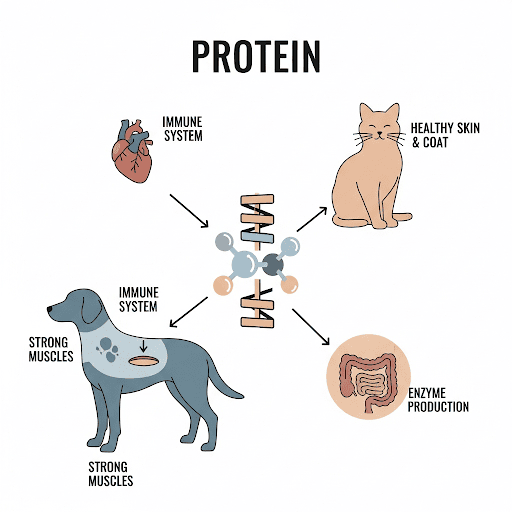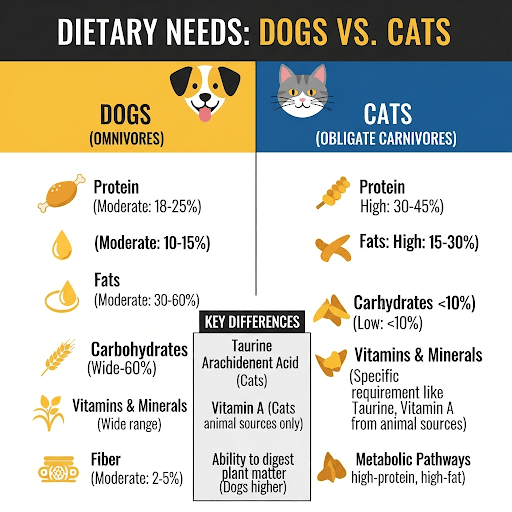Every time you look at your furry companion—whether they’re chasing a ball with boundless energy or purring contentedly on your lap—you’re seeing the result of good health. We all want our pets to live the most vibrant, joyful life possible. But what is the true foundation of that vitality? While the answer lies in their food bowl, the single most important ingredient is often misunderstood: protein.
Protein is far more than just a component of pet food; it is the master nutrient, the king of the building blocks that construct and power your pet’s entire body. This article will explore why protein is absolutely essential and how ensuring your pet gets the right kind, and the right amount, is the greatest gift you can give their health.
More Than Just Muscle: What Protein Actually Does
When we think of protein, we often think of strong muscles, and that’s certainly true. But its role is vastly more complex and critical. Protein provides the essential materials for nearly every biological process within your pet.
Think of protein as the master construction crew for your pet’s body. It is broken down during digestion into its individual components, called amino acids. These amino acids are then reassembled to:
- Build and Repair Tissues: From strong muscles and bones to healthy skin, ligaments, and cartilage.
- Create a Shiny Coat: Hair and fur are made up of approximately 95% protein. A dull coat is often one of the first signs of a dietary deficiency.
- Fuel the Immune System: Amino acids are used to create antibodies and enzymes that fight off disease and keep your pet healthy.
- Produce Hormones and Enzymes: These are vital messengers that regulate metabolism, digestion, and countless other functions.
There are 22 amino acids your pet needs, and while they can synthesize some internally, there are 10 (for dogs) and 11 (for cats) essential amino acids that must come from their diet. Without these, the entire construction crew grinds to a halt. Ensuring the protein in your pet's diet is complete and rich in these building blocks is non-negotiable for their health.
The Quality Question: Not All Proteins Are Created Equal
It’s not enough to see "protein" on a pet food label; the source of that protein matters immensely. The key concept here is bioavailability—a measure of how efficiently your pet’s body can absorb and use the amino acids from a protein source.
Generally, animal-based proteins (like chicken, beef, fish, and lamb) have a higher bioavailability for dogs and cats than most plant-based proteins. For cats, who are obligate carnivores, this is especially critical. Their bodies are specifically adapted to thrive on animal tissue.
Getting this balance right—choosing high-quality protein sources and ensuring the correct amount for your pet's unique needs—can feel complex. Taking the guesswork out of portion sizes and nutrient ratios is exactly why a smart meal planner app can make life easier for pet parents. It helps customize a plan with the right amount of high-quality protein based on your pet’s age, breed, weight, and activity level, ensuring they get precisely what they need to flourish.
Decoding Protein on the Pet Food Label
So, how can you spot high-quality protein when you’re shopping? Start by looking at the first few ingredients on the label. You want to see specific, named animal sources.
Excellent: "Deboned chicken," "lamb meal," "salmon," "whole eggs."
Be Cautious Of: Vague terms like "meat and bone meal" or "animal by-products," which can be inconsistent in quality.
A common myth is that a high-protein diet is dangerous for healthy pets. For a normal, active dog or cat without pre-existing kidney conditions, the body is well-equipped to handle high-quality protein. Excess protein is simply converted and used for energy. The real issue isn't the quantity, but the quality. Poor-quality, less digestible protein puts more strain on the body to excrete its waste products.
(For a deeper dive into labels, read our article on How to Read Pet Food Labels.)

Conclusion: Fueling a Lifetime of Health with the Right Building Blocks
Protein is not just another ingredient; it is the very engine of your pet's health and longevity. From their playful pounce to their glossy coat and strong immune defenses, every aspect of their well-being is built upon a foundation of high-quality amino acids.
By choosing foods with bioavailable, animal-based proteins and ensuring the portions are correct, you are making the single most powerful decision for their long-term health. Don’t feel overwhelmed by the science; understanding these basics is the first and most important step.
Ready to build the perfect, protein-powered diet for your best friend? Talk to your veterinarian about your pet’s specific needs, and explore how our pet meal planner app can help you craft a precise, nourishing plan that fuels a lifetime of happiness.


